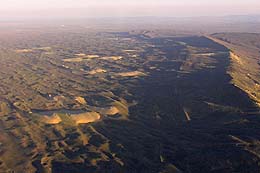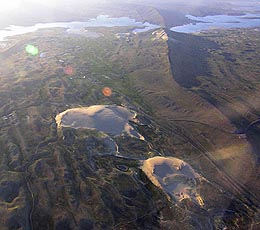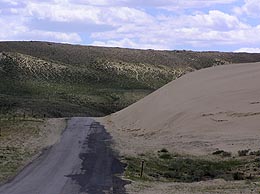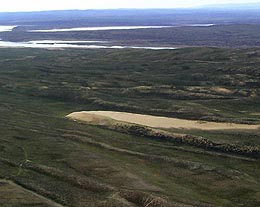






powered by SignMyGuestbook.com

| Newest
Older Previous Next Random Contact Profile Host |
blizzard warnings - 13:52 , 03 October 2013 heelerless - 21:32 , 18 August 2013 Red Coat Inn in Fort McLeod - 11:38 , 23 June 2013 rushing into the waters - 09:53 , 21 June 2013 choosing a spot - 17:43 , 27 April 2013 |
sand dune tracks
You can't really see them until you're in the air. Or looking at a satellite image.
The tracks of sand dunes.

I guess "tracks" wouldn't be the best word. The ridges left alongside where the dune passed are more like lateral moraines, the crushed rock shoved aside by glaciers, than anything else. But of course, these lateral ridges are not anything shoved aside by a pile of blowing sand. They're bits of the sand dune itself, grabbed from the side by vegetation, stabilized and forced to stay, held by roots, stems and leaves. While the middle of the dune moves on.
And move it does, loose grains being blown from the shallow, upwind end over the crest, to fall down the steeper, leeward side. Grain by grain, the dune moves.
If the age of the skeleton of the man murdered and then buried under the leeward edge of one of these dunes is any indication, it takes real close to a century for one of these dunes to pass a given spot. Looking at the dunes above, that's a century for the ground buried at the front of the dune to finally become exposed again at the trailing end.
Look at the length of some of those trails. Some of those dunes have been active, edging across that basin, for over a millennium. All heading northeast out of the Divide basin, until they run up onto rocky Cheyenne Ridge. You can see bare sand on top of that ridge on the right, there. I used to wonder how that sand came to be there, what combination of air currents and climate would happen to pile up sand right here.
Then I saw it from the air. And realized the sand wasn't deposited there.
It crawled up there. A grain at a time, it rolled across the basin and then rolled up the ridge. To be spilled by the wind onto the northern side. A process that was well along when I first drove up that dune a quarter century ago, and seems to have barely changed in all that time.
The northern slope of that ridge is almost all sand, dunes that had reached the crest and spilled over, most of their grains stabilized by grasses, sage, bitterbrush and rabbitbrush, and even a few pines. Plants all able to conquer and grab the sand because of the extra moisture that lingers from the winter's snowbanks.
But occasionally, a dune seems to be able to overwhelm the vegetation, and continues its march on the northern side.

Here the prevailing winds are different, and the dunes turn east, headed to what used to be a river. In the past, I assume any dune that reached the river was slowly hauled away by the water, the grains being scattered from here to the sandbars in Nebraska, and maybe even to the Mississippi delta. If the reservoir is still there five centuries from now, when these active dunes finally reach the water, I wonder if they will be carried away by the currents, or simply fill in the channel.
The front dune in that photo has been stalled for several decades, its leading edge trying to swallow the main county road.

Road crews have held it back, removing sand each year to keep the road open, spreading those grains across the county for traction on icy, winter roads. And the public has been encouraged to help with the removal, with a free source of sand. Sand from that dune filled our boys' sandbox when they were small. Sand from that dune is in the concrete wall around our front flower bed.
But the dune is about to win. The road is to be rebuilt in the next year or so, and wiser heads have decided to reroute it.
Upwind of the two dunes.
And the dune will be allowed to finally consume the pavement that has been frustrating it for so many years. Which, I suppose, will resurface in a century or so. Perhaps an archeologist's treasure, a record of late-1900s construction techniques. Or perhaps a mineable source of rare hydrocarbons.
Also in about a century, or so, a set of canid bones should come to light at another nearby dune.

The remains of the heeler sisters' big brother.